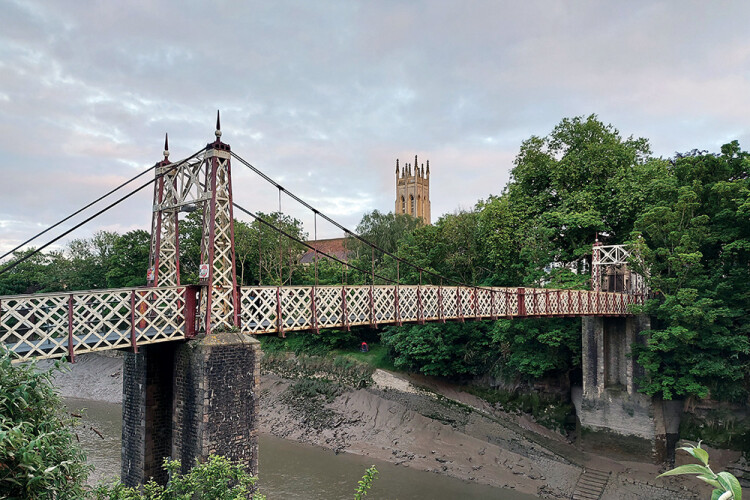Bristol is well blessed with bridges. From the majesty of the Clifton Suspension Bridge straddling the Avon Gorge to the more prosaic M5 bridge at Avonmouth which provides a pivotal route marker for traffic-locked motorists, the city and it environs are a pontist’s delight.
Even away from these well-known landmarks there is a myriad of road, rail and foot bridges that provide essential routes around the city, criss-crossing the harbour, rivers and manmade waterways that ensured Bristol’s development as a seafaring city.
One such example is that which spans the New Cut of the river Avon at Gaol Ferry. Built in the 1930s this ornate pedestrian suspension bridge replaced a ferry crossing that linked the suburbs of Southville and Bedminster to the city’s dockside near the site of its old prison.
Once the preserve of dock-workers heading to and from the busy harbour, it has become an important pedestrian link to the city centre and nearby Wapping Wharf, an achingly cool collection of waterside apartments, bars and restaurants that has sprung up alongside the site of the old gaol. Daily pedestrian and cycle traffic across it now tops 14,000 movements – way more than it was initially designed for.
A rolling inspection programme of general maintenance checks every two years and ‘principal’ inspections every six by Bristol City Council have kept the crossing in working order over the decades but during its last principal inspection engineers discovered that it had seriously degraded and was in need of urgent repair.
“The principal inspections include material testing and monitoring of the bridge. The last round showed that we needed to face up to the decision to either get on with major repair work – or close it completely,” says Chris Dooley, bridges and highways structures manager at Bristol City Council.
With the bridge such an important link into Bristol city centre, all options for its repair were considered. But ultimately it was in such a poor condition that only a full closure to enable access across the full width of the deck would enable the council’s framework contractor, Griffiths, to progress the work.
“At just 3m it is a very narrow deck. There wouldn’t have been the room to enable our teams to fully access it and maintain a safe pedestrian route,” explains Griffiths’ contract manager Ian Davies.
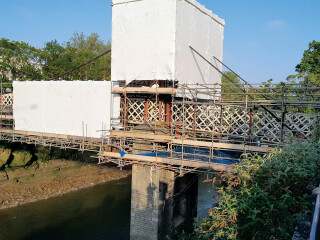
But even with the decision taken to close the bridge completely, the structure has thrown up more than its fair share of challenges for the project team. Such were the fears over its loadbearing capability that an imposed load limit of just 5kN – in addition to the weight of the access scaffold and encapsulation temporary works – has been enforced during the refurbishment process, significantly impacting the progress of the work.
“That limitation has meant that we have had to look at every aspect of the job and see how it would impact the loading – right down to the number of operatives we can have on the structure at any one time: a maximum of five,” says Davies.
Even that maximum has been reduced during some of the main aspects of the work thanks to the weight of the material and plant being used, with three in a team during grit-blasting and a steel fabrication team of just two or three operatives.
Gaol Ferry Bridge sits in a tough marine environment. There is still a 7m tidal range throughout the New Cut and its water is brackish even this far upriver from the sea, providing a corrosive cocktail that the bridge has endured for its 90 years.
The direction of the prevailing winds and shadow provided by the dense foliage on the river’s south bank had accelerated the bridge’s degradation on that side and so the Griffiths team elected to begin its work at the southern end, moving the 10m encapsulation tent sequentially across the 60m span towards the north pier.
It has been a slow process with progress hampered by the inability to assess each structural member’s integrity until grit-blasting had removed the years of paint. In some places it was little more than the paint that was holding the bridge in place.
“It was far worse than we could have imagined. There were some sections that were paper-thin or had corroded entirely,” says Dooley.
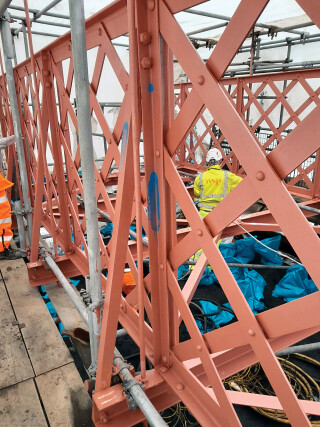
Each individual member needed to be inspected and assessed for its integrity before being cleared for repair or complete replacement. Prior to work beginning, the project team had identified that around 30% of the bridge would need to be replaced. In fact closer to 60% of its steel has been identified as having a sectional loss of more than 20% – the marker at which members are replaced rather than repaired.
“You don’t really know exactly what you are dealing with until it has been grit-blasted back to bare metal. At the towers there were areas where effectively there was no structural steel left,” says Davies.
The bridge beams, cross beams, uprights and outriggers were the worst affected areas with the delicate lattice parapets having survived reasonably intact. As work has progressed the team has been able to hold replacement steel at its supplier’s depot and bring material in as required – a bonus given the lack of any real compound space alongside the site.
“At the beginning of the project we invested in a lot of additional steel, which meant we have been insulated a little from fluctuating material prices. But there have been open and honest discussions when prices have proved volatile,” says Davies.
Despite being a well-loved structure in this part of Bristol, the Gaol Ferry Bridge is not listed in any way. Nevertheless the team has been as faithful to the original design as possible.
The 1930s connections across the bridge deck, upstands and its lattice parapets are rivetted but the new connections are friction bolted and capped to replicate the original rivet heads. The original timber deck is being replaced with 1,500 x 150 x 50mm UV-stable glass-reinforced polymer decking.
Once the steel fabrication work is complete the coatings team is brought in to prime and paint the section of bridge using a two-part polymer coating.Then the encapsulation tent is derigged and moved to the next 10m run and the cycle of grit-blasting, identification, repair or replace begins again.
Since the bridge was shut in August 2022, Griffiths and the project team have worked their way across the span. They are now at the final location, working on those corroded sections at the northern bank of the river with a view to completing their work and reopening the bridge within weeks.
“This is the first major work the bridge has had carried out on it for almost 100 years,” says Dooley. “When work is complete it will be as good as new.”
It has been a long 12 months for those 14,000 Bristolians that cross the Gaol Ferry Bridge daily; its reopening will be no doubt be celebrated in the bars and cafes of Wapping Wharf.
| Project: | Gaol Ferry Bridge refurbishment |
| Project Cost: | £1.5m |
| Client: | Bristol City Council |
| Main Contractor: | Griffiths |
| Project Start: | Aug-22 |
| Project Completion: | Sep-23 |
Bristol fashions bridge bonanza
The work that Griffiths is carrying out at Gaol Ferry Bridge is just the start of a long-term programme that will see five other bridges in Bristol get the essential maintenance and repairs they require.
Funding for the suite of schemes has been set aside under the City Region Sustainable Transport Settlement and will see £15m spent over the next five years on the repair of Vauxhall Bridge, Langton Street Bridge, Sparke Evans Park Bridge, Bedminster Bridge and Bath Bridge as well as the work at Gaol Ferry.
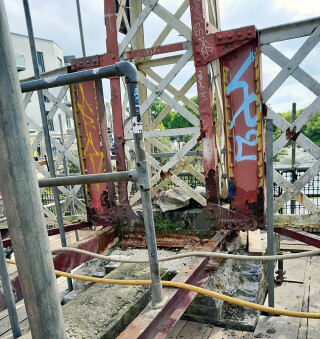
It is part of Bristol City Council’s bid to improve walking and cycling infrastructure across the city, helping boost air quality and reduce traffic congestion.
The bridge at Sparke Evans Park is next on the city council’s to-do list for Griffiths and the team is confident that, given the similarity between the two structures, lessons learnt during the Gaol Ferry project will be reflected when they move up-river to the new site.
BOX 3
Option, options, options
Given the high traffic volume crossing the Gaol Ferry Bridge it is understandable that the project team assessed all the options available to them carefully before taking the difficult decision to close it completely and divert pedestrians and cyclists.
One possibility could have been to provide a temporary bridge alongside the existing but this was dismissed immediately, largely due to the amount of services that run behind the existing walls of the New Cut.
“The walls would have required anchoring back using rock bolts and then services diverted around. It would’ve created more problems than it solved,” says BCC’s bridges and highways structures manager Chris Dooley.
Other options that were discussed with varying degrees of seriousness were the use of a floating ‘Mulberry Harbour’ type bridge and even the reintroduction of the passenger ferry, a service halted on completion of the bridge in the 1930s.
“In the end you have to look at the viability of all of the different options. Really the only feasible one was that of closing the bridge and diverting traffic around it. For such a simple piece of infrastructure it has provided a lot of questions,” says Dooley.
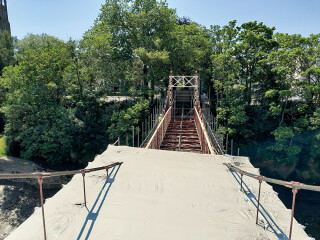
Got a story? Email news@theconstructionindex.co.uk

